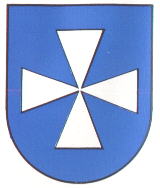Oberweier (Bühl): Difference between revisions
Jump to navigation
Jump to search
Knorrepoes (talk | contribs) No edit summary |
Knorrepoes (talk | contribs) m (Text replace - "'''Origin/meaning :'''<br/>" to "====Origin/meaning====") |
||
| Line 17: | Line 17: | ||
In Blau ein silbernes Malteserkreuz ohne Kerben. | In Blau ein silbernes Malteserkreuz ohne Kerben. | ||
====Origin/meaning==== | |||
The oldest seal of Oberbruch dates from the early 19<sup>th</sup> century. It showed in a divided shield the arms of [[Baden (State)|Baden]] and in the lower half a cross. The cross is most likely the old village sign. Later 19<sup>th</sup> century seals show only the cross, most often in a crowned shield. | The oldest seal of Oberbruch dates from the early 19<sup>th</sup> century. It showed in a divided shield the arms of [[Baden (State)|Baden]] and in the lower half a cross. The cross is most likely the old village sign. Later 19<sup>th</sup> century seals show only the cross, most often in a crowned shield. | ||
Revision as of 07:43, 1 April 2012
| Heraldry of the World Civic heraldry of Germany - Deutsche Wappen (Gemeindewappen/Kreiswappen) |
OBERWEIER
State : Baden-Württemberg
District (Kreis) : Rastatt (until 1972 Bühl)
Incorporated into : 1972 Bühl
Official blason:
In Blau ein silbernes Malteserkreuz ohne Kerben.
Origin/meaning
The oldest seal of Oberbruch dates from the early 19th century. It showed in a divided shield the arms of Baden and in the lower half a cross. The cross is most likely the old village sign. Later 19th century seals show only the cross, most often in a crowned shield.
When the municipality asked for official approval, the State Archives proposed the above arms, in which the cross was replaced by a Maltese cross. The village has, however, never had anything to do with the Knights of Malta.
Literature : Zier, 1964.

